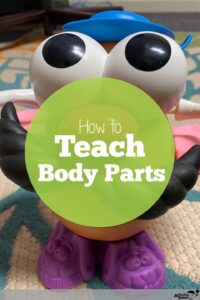Teaching children body parts develops vocabulary, but it also helps with confidence and positive self-image. Children start identifying basic body parts like “nose” around a year. More specific words like “wrist” and “knee” are mastered around age five. Let’s look at some activities we can use to work on this classic language goal.
Activities may contain Amazon affiliate links.
Bathing baby dolls
A shallow bin of water, a baby doll and a washcloth are all you need for some splashing fun! (Oh, maybe add a towel beneath the bin.) Label all the parts of baby that you are cleaning, but be sure to add in some action words too—splash, wash and dry. Late talkers often need extra support with verbs.
Potato Head
Mr. and Mrs. Potato Head are another classic opportunity to teach body parts. Rather than dumping out all the pieces at once, try placing the body parts in a bag (like a pillowcase). You can talk about which body part you need/want and then see if that’s the one you pull out for extra labelling opportunities.
Boo-boo babies
Most little ones love the drama of wearing a band aid and believe in its intrinsic healing powers. But they don’t often get the chance to experiment with band aids all by themselves! Having a doll that cries (“wha-wha”) or says “ow!” gives our very earliest language learners a chance to work on exclamations in addition to the body parts vocabulary where the “owie” is.
Vary the activity by playing doctor and having littles label where it hurts. For older students you can use higher level vocabulary like knee, wrist, ankle, elbow and chin.
Buy an assortment of band-aid sizes to work on the early language concepts of “big” and “little.”
Pro tip: you can buy inexpensive band-aids at dollar stores though they don’t have much sticking power (a pro and a con). Target brand band-aids are a happy medium between cost and actually sticking.
Body Part Songs
There are a few songs that label body parts and they cover a wide range of ages. You can even adapt them to work for more specific vocabulary with older children.
If You’re Happy and You Know It: This song has a lot of movement built in and is appropriate for our littlest learners who can clap hands, stomp feet, and nod their heads. Pro tip: Trying to engage your littles in books? Try illustrated songs! This particular song also comes in holiday versions.
Do the Hokey Pokey: This song can be used with young ones or older ones that are working on left and right. Another great option to get your kids moving!
Head, Shoulders, Knees and Toes: The repetition of this song is great for working on body parts vocabulary. Adults tend to speed up the rhyme, but when you’re starting, be sure to keep it nice and slow.
Have other ideas for teaching body parts? Share below!







